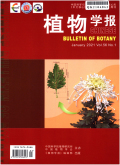植物学报2024,Vol.59Issue(4):533-543,11.DOI:10.11983/CBB24015
盐肤木APETALA3/DEFICIENS同源基因的克隆与功能分析
Cloning and Functional Analysis of APETALA3/DEFICIENS Homologous Gene from Rhus chinensis
摘要
Abstract
The APETALA3/DEFICIENS(AP3/DEF)gene is a B-class gene of the MADS-box gene family,which is mainly involved in the regulation of petal and stamen development during flower development.Cloning and analysis of the AP3/DEF homologous genes from Rhus chinensis can help exploring their role in the development of stamen.The CDS of AP3/DEF homologous gene was obtained using RT-PCR;its sequence and structural domains were compared and ana-lyzed by NCBI CD Search;interactions between AP3/DEF homologous proteins and other MADS-box transcription factors in R.chinensis were verified by using yeast two-hybrid system;real-time fluorescence PCR was used to analyze the spa-tial and temporal expression patterns of the AP3/DEF homologous genes;overexpression in Arabidopsis was conducted to verify the function of the AP3/DEF homologous genes in flower organ development.Two coding sequences of AP3/DEF homologous genes in R.chinensis were cloned and named RcAP3(GenBank:OR962160)and RcTM6(GenBank:OR962159).Based on the alignment of their conserved amino acid domains and phylogenetic analysis,these two protein sequences showed the closest genetic relationship to the AP3/DEF homologous gene-encoded proteins in the Anacar-diaceae family,including Mangifera indica and Pistacia vera.The yeast two-hybrid results showed that RcAP3 and RcTM6 interacted with the B-class protein RcPI,the C-class proteins RcAG and Rcag in R.chinensis,but not with the A-class and E-class proteins.Real-time fluorescence quantification results demonstrated that RcAP3 and RcTM6 were highly expressed during the rapid growth stage of flower buds in different sexes of R.chinensis,with lower expression levels during the early bud development and after flowering.RcAP3 exhibited high expression levels during buds diffe-rentiation in female,male,and hermaphrodite flowers,while RcTM6 showed significant expression in hermaphrodite flowers and very low expression in male and female flowers.During the rapid growth stage of hermaphrodite flowers,RcAP3 was highly expressed in both petals and stamens with minimal differences,whereas RcTM6 showed significantly higher expression in stamens compared to other floral organs.RcAP3 could restore the petal and stamen phenotypes in the ap3-3 mutant of Arabidopsis,while overexpression of RcTM6 resulted in shortened petals,stamens,and aborted ovaries in Arabidopsis.Functional differentiation exists between the AP3/DEF subfamily homologous genes,RcAP3 and RcTM6.RcAP3 promotes petal and stamen development,while RcTM6 inhibits stamen development.These findings provide a foundation for further research on the molecular mechanisms underlying sex differentiation in R.chinensis.关键词
盐肤木/RcAP3/RcTM6/表达模式/功能分析Key words
Rhus chinensis/RcAP3/RcTM6/expression pattern/functional analysis引用本文复制引用
顾磊,张棋,张霞,杨冰冰,王芳岚,刘文,陈发菊..盐肤木APETALA3/DEFICIENS同源基因的克隆与功能分析[J].植物学报,2024,59(4):533-543,11.基金项目
国家自然科学基金(No.32370393)和湖北省中央引导地方科技发展专项(No.2022BGE265) (No.32370393)

